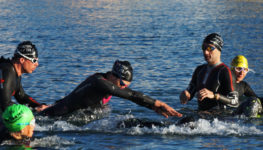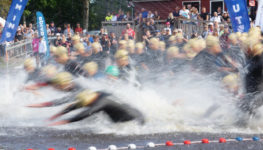Developing the PUSH in the swim stroke
As a triathlete, you want to swim, bike and run faster?! Swimming may not be your favourite discipline, but it should not be neglected. Working on your swim stroke is VERY important as swim performance has a direct impact on your triathlon performance.
Swimming more often is one thing, swimming at the right intensity and focusing on the right things is another. Simply training to swim faster, at “race pace” (CSS pace or threshold levels), plodding up and down to cover the distance or adding lots of drills is not the best approach.
As a triathlete, your real goal should be to develop a swim stroke that makes you fast with minimal effect on your overall fatigue. Initially, becoming a more efficient swimmer (using less energy) is more important than becoming faster. Your swim does impact your bike, your bike impacts you run; become more efficient and you will finish faster!
PUSH – the ONE thing that makes you faster
Simplistically, the swim stroke requires a replication of arm movements along with a rhythmical leg action. For triathlon, all your emphasis should be place on developing your arm action rather than the legs (kicking consumes too much energy for very little return, and you’ll need your legs later).
All your movement should be repetitions of simple movements, contrary to many swim myths that say you must reach, catch, etc.
Think about it in simple mechanical terms: to swim (move) forwards you need to PUSH water backwards.
It makes sense then that the ONLY part of the swim stroke that makes you move forward is the PUSH. After the hand has been placed in the water and pressed down to get your fingers pointing down the push occurs. After that the hand/arm recovers.
The push is the main part of the swim stroke that we always see to be under-developed, even in fast swimmers, mainly due to the focus being on the front of the stroke (that is not effective) rather than the back of the stroke.
Swim as adult triathletes
For adult (non-swimmer) triathletes, the arm movement will very often have to be different to that of someone who has been swimming since their youth. We covered adult restrictions in a previous blog, while discussing why we use buoyancy tools.
Keeping the movement simple is key to adult development, and simply the swim stroke is:

- “Place” the hand in the water – top image
- “Press” the fingers down to point to the floor – middle image
- PUSH the hand back to arm’s length – third image
- “Recover” the arm to repeat the movement
It is as simple as that!
The key phase of the swim stroke is the PUSH, it’s the only part that moves your forwards. The place does nothing, the press lifts, the push moves you and the recovery does nothing.
Remove all those unnecessary technical terms that you have had thrown at you and focus on pushing water backwards. Swimming as an adult is DIFFERENT to swimming as a child / youth.
Realise that, follow this simple advice, use the ability and strength you have, and you will find swimming becomes so much easier. You will become faster and more efficient.
Build strength
To help you develop a good PUSH, adding some buoyancy usually helps (shorts and or pull buoy) to put your body into a better position (for most people). When you´re in a good elevated position, add some swim paddles for added resistance. Paddles size is important, ones that are not too big, to keep your shoulders healthy. It will be like going to the gym; you will load the upper body muscles and build their strength.
Not only will you build strength, you will “feel” the water – as the water is pressed against the paddle the solid structure of the paddle is felt against the fingers and palm.
Movement not technique
The PUSH is not a “technique”, it is a movement. It is a movement you rarely see listed in the swimmers “must” do list (like the “reach” and “catch”). However, as you now know, it is the only movement that provides propulsion. Luckily, it is an easy action that we can all associate with.
“PUSH” describes exactly what you need to do – PUSH water backwards. It’s an easy action to visualise and is why coaching cues are important.
“Pull” is the common name to describe the swim stroke/arm action. There is NO movement in the entire swim stroke that can be mechanically or descriptively called a “pull”. You are never pulling, only pressing and PUSHing water.
Focussing on a good PUSH (to arms-length, red circle on image below) will make you conscious of the power you can generate. PUSH hard and you’ll also notice you start using muscles in a new way, and probably discover “new” unused ones 😆

Conclusion
Changing how you view the swim stroke and approach to swimming will aid your development. Keep it simple; the movements are:
- Place your hands shoulder width apart in the water – no reaching
- Press your fingers down straight away – no gliding
- PUSH the water backwards HARD to arms-length
- Recover the hand back to the place in a relaxed and natural manner
These simple movements will help you relax (reducing your thought list) and use your strength where you need it – to push water backward s and move you forwards.
PUSH if you want to go fast!



